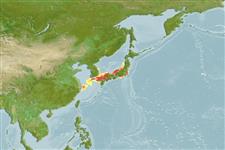Environment: milieu / climate zone / depth range / distribution range
Ekologi
marina bottenlevande. Temperate
Northwest Pacific: Japan Sea off coast of northern Honshu, Japan.
Size / Vikt / Age
Maturity: Lm ? range ? - ? cm
Short description
Bestämningsnycklar | Morfologi | Morfometri
Taggstrålar i ryggfenan (totalt) : 11 - 13; Mjukstrålar i ryggfenan (totalt) : 9 - 10; Taggstrålar i analfenan: 0; Mjukstrålar i analfenan: 17 - 20. Closely resembles O. iburia in general appearance, but differs by having a few enlarged subpectoral plates, and 35 or fewer dorsolateral and ventrolateral plates.
Life cycle and mating behavior
Maturities | Reproduktion | Spawnings | Egg(s) | Fecundities | Larver
Masuda, H., K. Amaoka, C. Araga, T. Uyeno and T. Yoshino, 1984. The fishes of the Japanese Archipelago. Vol. 1. Tokai University Press, Tokyo, Japan. 437 p. (text). (Ref. 559)
IUCN Red List Status (Ref. 130435)
Threat to humans
Harmless
Human uses
Verktyg
Special reports
Download XML
Internet-källor
Estimates based on models
Phylogenetic diversity index (Ref.
82804): PD
50 = 0.5625 [Uniqueness, from 0.5 = low to 2.0 = high].
Bayesian length-weight: a=0.00389 (0.00180 - 0.00842), b=3.12 (2.94 - 3.30), in cm total length, based on all LWR estimates for this body shape (Ref.
93245).
Trofisk nivå (Ref.
69278): 3.2 ±0.3 se; based on size and trophs of closest relatives
Resiliens (Ref.
120179): Mellan, lägsta populationsfördubblingstid 1,4-4,4 år (Preliminary K or Fecundity.).
Fishing Vulnerability (Ref.
59153): Low vulnerability (16 of 100).
